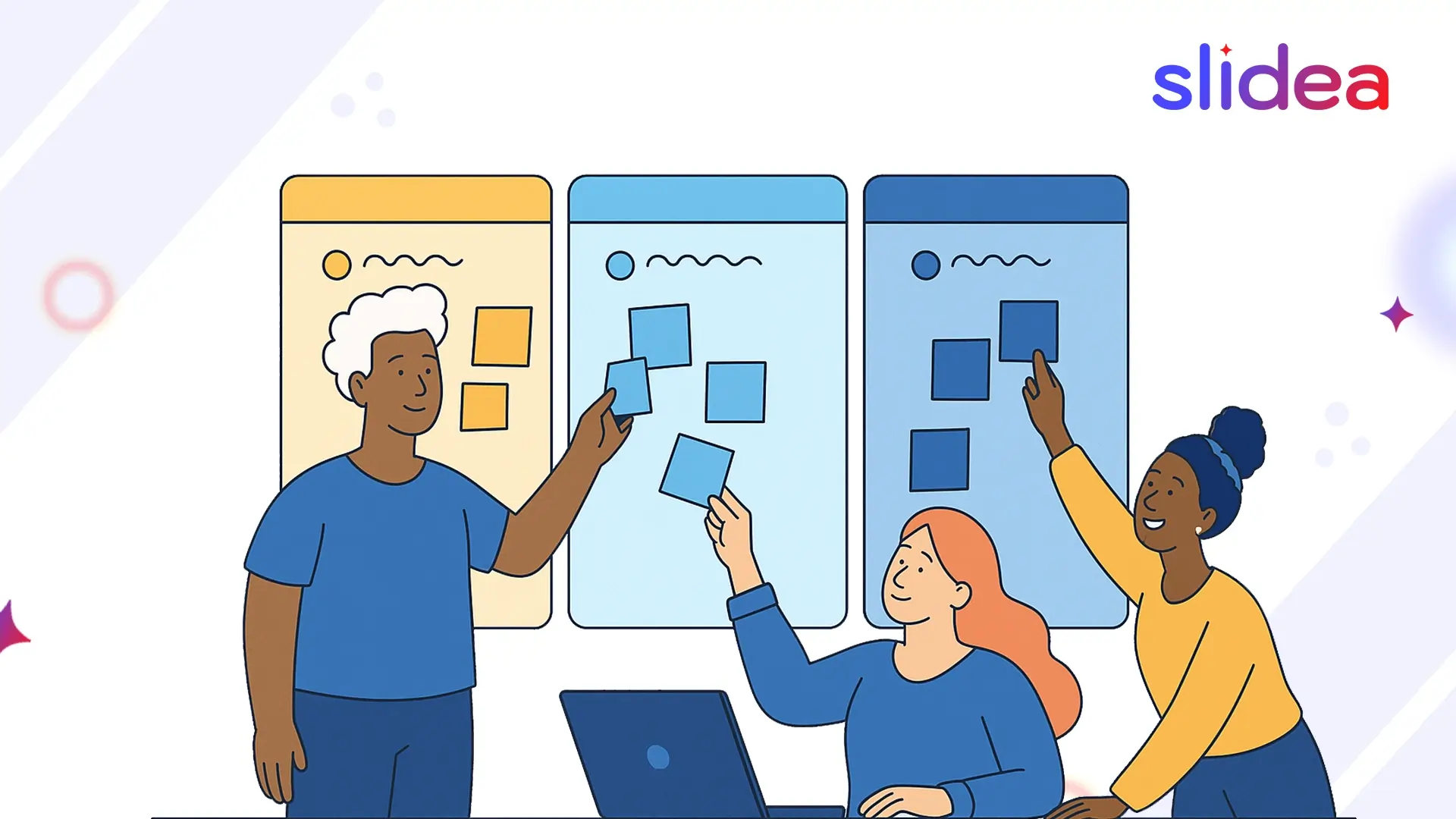Too many meetings feel like time traps, lots of talk, little action. The real game-changer? A well-crafted agenda that guides discussions, keeps everyone focused, and sparks collaboration.
By combining clear agenda planning with interactive meeting tools, teams can turn long, draining sessions into engaging, results-oriented conversations. With real-time input, shared decision-making, and actionable takeaways, meetings stop being just calendar blocks and start becoming productivity powerhouses.
Why Most Meeting Agendas Fail
Traditional agendas often read like grocery lists, item after item with no clear structure, timing, or clear outcomes. Participants join unsure of their role, the decisions needed, or what success looks like.
A productive meeting agenda:
- Connects every item to a clear objective
- Allocates realistic time for each topic
- Assigns clear roles for participants
- Uses action-oriented language like “decide,” “review,” or “plan”
When meetings are planned this way, they stay focused, run on time, and result in meaningful outcomes.
What Should a Meeting Agenda Include?
Here’s what every good meeting agenda needs with short and clear descriptions:
| Agenda Item | Description |
| Title of the Meeting | A clear, short name to identify what the meeting is about. |
| Date and Time | Let participants know when it starts and how long it will last. |
| Meeting Objective | A one-line goal, why the meeting is being held. |
| List of Topics | Key points or problems you plan to discuss. |
| Person Responsible | Assign who will lead or speak on each topic. |
| Estimated Time per Topic | Helps manage time and keep the meeting on track. |
| Space for Notes/Decisions | For jotting down outcomes or actions agreed upon. |
The Anatomy of a Productive Agenda
- Clear Objectives – Every agenda item should have a purpose: inform, decide, brainstorm, or plan.
- Time Allocation – Add realistic time blocks to keep discussions moving.
- Participant Roles – Let people know their role: presenter, decision-maker, or contributor.
- Action-Oriented Language – Use active verbs to set expectations.
Meeting Agenda Examples You Can Use
1. The Problem-Solving Agenda
Perfect for tackling challenges head-on. This agenda keeps discussions structured so you don’t waste time going in circles.
Structure:
- Welcome & Objective (5 mins)
- Outline the Problem (10 mins)
- Gather Input (15 mins)
- Propose Solutions (20 mins)
- Vote or Decide on Action (10 mins)
- Wrap-Up & Assign Tasks (5 mins)
2. The Project Update Agenda
When multiple people are working on the same project, updates can quickly become long-winded. This agenda keeps it short and focused.
Structure:
- Quick Recap of Project Goal (5 mins)
- Progress Updates from Each Member (3 mins each)
- Identify Bottlenecks (10 mins)
- Plan Next Steps (10 mins)
- Confirm Deadlines (5 mins)
3. The Brainstorming Agenda
Ideal for generating fresh ideas in creative teams.
Structure:
- Set the Stage (5 mins)
- Present the Topic or Challenge (5 mins)
- Idea Dump Session (15 mins)
- Group Similar Ideas (10 mins)
- Vote for Top Ideas (10 mins)
- Plan Action Steps (5 mins)
4. The Decision-Making Agenda
For meetings where a final choice must be made.
Structure:
- State the Decision to Be Made (5 mins)
- Review All Options (10 mins)
- Discuss Pros and Cons (15 mins)
- Vote (5 mins)
- Assign Responsibilities (5 mins)
5. The Training Agenda
Helpful for onboarding or skill-building sessions.
Structure:
- Welcome & Objectives (5 mins)
- Overview of the Training Topic (10 mins)
- Interactive Learning Activity (15 mins)
- Practical Application (10 mins)
- Q&A (10 mins)
- Summary & Feedback Collection (5 mins)
6. The All-Hands Meeting Agenda
Best for large company updates or big announcements.
Structure:
- Welcome & Key Updates (10 mins)
- Department Highlights (5 mins each)
- Special Announcements (10 mins)
- Team Recognition (5 mins)
- Q&A Session (10 mins)
Meeting Types and Their Agenda Examples
| Meeting Type | Agenda Items Example |
| Team Meeting | Welcome, Project Updates, Roadblocks, Wins, Next Steps |
| One-on-One | Goals Review, Feedback, Support Needed, Career Check-in |
| Project Kickoff | Introductions, Project Scope, Timelines, Roles, Q&A |
| Client Meeting | Introductions, Updates, Action Items, Feedback, Next Steps |
| Strategy Meeting | Objectives, Key Metrics, Ideas Discussion, Final Plans |
| Stand-Up Meeting | Yesterday’s Work, Today’s Plan, Roadblocks |
| Quarterly Review | Metrics, Wins, Misses, Lessons, Plans Ahead |
Making Meetings Interactive with Slidea
A great agenda is only half the battle, keeping people engaged is the real challenge. This is where Slidea makes all the difference.
With Slidea, you can:
- Run Live Polls: Get instant feedback on decisions.
- Use Word Clouds: Visualize team priorities in real time.
- Host Interactive Q&A: Encourage questions without interrupting the flow.
- Track Engagement: See who’s participating and follow up later.
Final Thought
Unproductive meetings aren’t inevitable, they’re just the result of poor planning. With clear objectives, time limits, and the right interactive tools, you can turn every meeting into a focused, collaborative, and outcome-driven session.
Start with one of these agenda examples, make it your own, and use Slidea to keep every participant engaged from start to finish. The result? Shorter meetings, better decisions, and a team that actually enjoys showing up.
FAQs
Q1. Why do most meetings feel unproductive?
They lack clear goals, structure, and participant engagement.
Q2. How can I make my agenda more engaging?
Add interactive moments with polls, Q&A, and real-time feedback.
Q3. Should I send my agenda in advance?
Yes, this helps attendees prepare and participate effectively.
Q4. How does Slidea help with meetings?
It adds live interaction, visual engagement, and instant feedback to keep discussions productive.
Q5. Can these agenda formats work for virtual meetings?
Absolutely, just adapt them with breakout rooms, chat discussions, and Slidea’s digital tools.




Leave a Comment
Your email address will not be published. Required fields are marked *